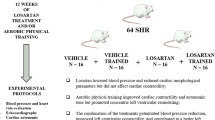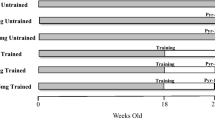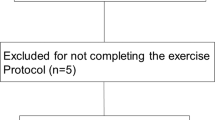Abstract
High levels of activity of the renin–angiotensin system (RAS) and sympathetic nervous system (SNS) are related to left ventricular hypertrophy (LVH). A percentage of subjects with hyperactivity to treadmill stress test show LVH to echocardiogram. This paper aims at evaluating neurohumoral influence over these subjects by comparing drugs that block both the RAS and the SNS. In a 1-year open protocol, 195 normotensive subjects, with hyperactivity to treadmill stress test and LVH, were randomly assigned to supervised physical exercise, rilmenidine 1 mg day−1, atenolol 50 mg day−1, enalapril 10 mg day−1 or losartan 50 mg day−1. Changes in left ventricular mass index (LVMI), measured by means of echocardiogram, were the primary end point. Changes in systolic blood pressure (SBP) at rest and peak effort were also evaluated. Enalapril significantly brought LVMI down in relation to the basal value (28.2%; n=36) similarly to losartan (26.9%; n=42); P>0.05. However, both were more efficient than physical exercise (2.9%; n=39), rilmenidine (5.1%; n=38) and atenolol (7.2%; n=40); P<0.001. There was no significant difference in SBP reduction at rest and peak effort in groups assigned to atenolol, enalapril and losartan; P>0.05. In such groups, reduction was greater than in groups assigned to physical exercise and rimenidine; P<0.001. In conclusion, drugs that block RAS were more efficient in reducing LVH than physical exercise and drugs that block SNS, and such reduction took place regardless of SBP level reduction at rest and peak effort.
This is a preview of subscription content, access via your institution
Access options
Subscribe to this journal
Receive 12 digital issues and online access to articles
$119.00 per year
only $9.92 per issue
Buy this article
- Purchase on Springer Link
- Instant access to full article PDF
Prices may be subject to local taxes which are calculated during checkout





Similar content being viewed by others
References
Casale PN, Devereux RB, Milner M . Value of echocardiographic measurement of left ventricular mass in predicting cardiovascular morbid events in hypertensive men. Ann Intern Med 1986; 105: 173–178.
Levy D, Garrinson RJ, Savage DB, Kannel WB, Castelli WP . Prognostic implications of echocardiographically determined left ventricular mass in the Framingham Heart Study. N Engl J Med 1990; 322: 1561–1566.
Drayer J, Gardin J, Brewer D, Webb M . Disparate relationships between blood pressure and left ventricular mass in patients with and without left ventricular hypertrophy. Hypertension 1987; 95 (Suppl): 1161–1164.
Ren J, Hakky A, Kotler MN, Iskandrian AS . Exercise systolic blood pressure: a powerful determinant of increased left ventricular mass in patients with hypertension. J Am Coll Cardiol 1985; 5: 1224–1231.
Benbassat J, Froom P . Blood pressure response to exercise as a predictor of hypertension. Arch Intern Med 1986; 146: 2053–2055.
Jackson AG, Squires WG, Grimes G, Beard EF . Prediction of future resting hypertension from exercise blood pressure. J Cardiac Rehab 1983; 3: 263–268.
Gottdiener JS, Brown J, Zoltick J, Fletcher RD . Left ventricular hypertrophy in men with normal blood pressure: relation to exaggerated blood pressure response to exercise. Ann Intern Med 1990; 112: 151–156.
Polônia J, Martins L, Bravo-Faria D, Macedo F, Coutinho J, Simões L . Higher left ventricle mass in normotensives with exaggerated blood pressure responses to exercise associated with higher ambulatory blood pressure load and sympathetic activity. Eur Heart J 1992; 13 (Suppl A): 30–36.
Lim PO, Donnan PT, MacDonald TM . Aldosterone to renin ratio as a determinant of exercise blood pressure response in hypertensive patients. J Hum Hypertens 2001; 15: 119–123.
Fagard RH, Cornelissen VA . Effect of exercise on blood pressure control in hypertensive patients. Eur J Cardiovasc Prev Rehabil 2007; 14: 12–17.
Fagard RH, Cornelissen VA . Physical activity, exercise, fitness and blood pressure. In: Battagay EJ, Lip GYH, Bakris GL (eds). Hypertension: Principles and Practice. Taylor & Francis Group: Boca Raton, USA, 2005, pp 195–206.
Higashi Y, Sasaki S, Kurisu S, Yoshimizu A, Sasaki N, Matsuura H et al. Regular aerobic exercise augments endothelium-dependent vascular relaxation in normotensive as well as hypertensive subjects. Role of endothelium-derived nitric oxide. Circulation 1999; 100: 1194–1202.
The Sixth Report of the Joint National Committee on Prevention. Detection, evaluation, and treatment of high blood pressure. Arch Intern Med 1997; 157: 2413–2446.
Bruce RA, Blackman JR, Jones JW . Exercise testing in adult normal subjects and cardiac patients. Pediatrics 1963; 32: 742–755.
Astrand PO, Rhyming I . Normogram for calculation of aerobics capacity (physical fitness) from pulse during submaximal work. J Appl Physiol 1954; 71: 218–221.
Bhanbhani Y, Buckley S, Maikala R . Physiological and biomechanical responses during treadmill walking with graded loads. Eur J Appl Physiol 1997; 76: 544–551.
Froelicher Jr VF, Brammell H, Davis G . A comparison of the reproducibility and physiologic responses to three maximal treadmill exercise protocols. Chest 1974; 65: 512–517.
Harrison MH, Brown GA, Cochran L . Maximal oxygen uptake: its measurement application, and limitations. Aviat Space Environ Med 1980; 51: 1123–1127.
Devereux RB, Alonso DR, Lutas EM, Gottlieb GJ, Campos E, Sachs I et al. Echocardiographic assessment of left ventricular hypertrophy: comparison to necropsy findings. Am J Cardiol 1986; 57: 450–458.
Sharabi Y, Ben-Cnaan R, Hanin A, Martonovitch G, Grossman E . The significance of hypertensive response to exercise as a predictor of hypertension and cardiovascular disease. J Hum Hypertens 2001; 15: 353–356.
Wilson NV, Meyer BM . Early prediction of hypertension using exercise blood pressure. Prev Med 1981; 10: 62–68.
Wilson MF, Sung BH, Pincomb GA, Lovallo WR . Exaggerated pressure response to exercise in men at risk for systemic hypertension. Am J Cardiol 1990; 66: 731–736.
Dlin RA, Hanne N, Silverberg DS, Bar-or O . Follow-up of normotensive men with exaggerated blood pressure response to exercise. Am Heart J 1983; 106: 316–320.
Michelsen S, Knutsen KM, Stugaard M, Otterstad JE . Is left ventricular mass in apparently healthy normotensive men correlated to maximal blood pressure during exercise? Eur Heart J 1990; 11: 241–248.
Schimider RE, Martus P, Klingbeil A . Reversal of left ventricular hypertrophy in essential hypertension: a meta analysis of randomized double-blind studies. JAMA 1996; 275: 1507–1513.
Jennings G, Wong J . Regression of left ventricular hypertrophy: changing patterns with successive meta-analyses. J Hypertens 1998; 16 (Suppl 6): S29–S34.
Somers VK, Conway J, Johnston J, Sleight P . Effects of endurance training on baroreflex sensitivity and blood pressure in borderline hypertension. Lancet 1991; 337: 1363–1368.
Grassi G, Seravalle G, Calhoun AD, Mancia G . Physical training and baroreceptor control of sympathetic nerve activity in humans. Hypertension 1994; 23: 294–301.
Parrault H, Peronnet F, Cleroux J, Consineau D, Nadeau R, Phan Hey H et al. Electro- and echocardiographic assessment of left ventricle before and after training man. Can J Appl Sports Sci 1978; 3: 180–182.
Wolfe LA, Martin RP, Watson DD, Lasley RD, Bruns DE . Chronic exercise and left ventricular structure and function in healthy human subjects. J Appl Physiol 1985; 58: 409–415.
Cuspidi C, Muiesan ML, Valagussa L, Salvetti M, Di Biagio C, Zanchetti A et al. Comparative effects of candesartan and enalapril on left ventricular hypertrophy in patients with essential hypertension: The Candesartan Assessment in the Treatment of Cardiac Hypertrophy (CATCH) study. J Hypertens 2002; 20: 2293–2300.
Dahlöf B, Devereux RB, Kjeldsen SE, Julius S, Beevers G, Faire UD et al. Cardiovascular morbidity and mortality in the Losartan Intervention For Endpoint reduction in hypertension study (LIFE): a randomized trial against atenolol. Lancet 2002; 359: 995–1003.
Trimarco B, Morisco C, Sarmo D, Iovino G, Argenziano L, Russo R . Rilmenidine in patients with left ventricular hypertrophy: beyond the reduction of left ventricular mass. J Cardiovasc Pharmacol 1995; 26 (Suppl 2): S29–S33.
Goodfriend TI, Elliot ME, Catt KJ . Angiotensin receptors and their antagonists. N Engl J Med 1996; 334: 1649–1654.
Kopin IJ . Catecholamine metabolism: basic aspects and clinical significance. Pharmacol Rev 1985; 37: 333–364.
Goldstein DS . The Autonomic Nervous System in Health and Disease. Marcel Dekker, Inc.: New York, NY, 2001.
Brown EJ, Schreiber SL . A signaling pathway to translational control. Cell 1996; 86: 517–520.
Fossum E, Olsen MH, Hoieggen A, Wachtell K, Reins HM, Ibsen H et al. Long-term plasma catecholamines in patients with hypertension and left ventricular hypertrophy treated with losartan or atenolol: ICASUS, a LIFE substudy. J Hum Hypertens 2004; 18: 375–380.
Schunkert H, Hence HW, Holmer SR, Stender M, Perz S, Keil V et al. Association between a deletion polymorphism of angiotensin-converting enzyme gene and left ventricular hypertrophy. N Engl J Med 1994; 330: 1634–1638.
Acknowledgements
We thank the Alquimia Drugstores for donation of all drugs used in the study; The Espirito Santo Hospital Military Police, where patients were attended to and complementary examinations were carried out; and the Heart Institute (InCor), University of São Paulo Medical School for all technical support required for the accomplishment of this study.
Author information
Authors and Affiliations
Corresponding author
Rights and permissions
About this article
Cite this article
Avanza, A., Mansur, A. & Ramires, J. Efficacy of exercise, losartan, enalapril, atenolol and rilmenidine in subjects with blood pressure hyperreactivity at treadmill stress test and left ventricular hypertrophy. J Hum Hypertens 23, 259–266 (2009). https://doi.org/10.1038/jhh.2008.127
Received:
Revised:
Accepted:
Published:
Issue Date:
DOI: https://doi.org/10.1038/jhh.2008.127



